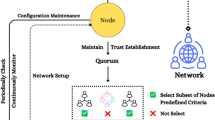Abstract
In this paper we investigate the impact of transaction validation of two tip selection mechanisms in DAG blockchains such as the tangle of IOTA on the performance of the consensus mechanism. The tip selection algorithm determines which prior transactions are validated by a transaction. With validating a tip a transaction is appended to the tangle. We present TangleSim, our simulator based on OMNeT++, which allows to evaluate the transaction validation time and the time a transaction will spend as a tip in DAG blockchains. We find that the weighted random walk selection can achieve a lower transaction validation time than the random tip selection algorithm in many cases.
The work was done while the author was at Cardiff University.
Access this chapter
Tax calculation will be finalised at checkout
Purchases are for personal use only
Similar content being viewed by others
Notes
- 1.
PayPal, during second quarter of 2018 processed 2,327,000,000 transactions which equates to an average of 294.93 Tx/s.
- 2.
Available on Github at https://github.com/richardg93/TangleSim.
- 3.
It has been shown that given certain conditions and strategies this proportion can decrease to 30% [8].
- 4.
- 5.
The network choosing to discard a sub-chain for a longer sub-chain could be considered a state change as well. In contrast, in the Tangle transactions attached are never discarded, but can be left behind when other transactions choose not to approve them.
- 6.
The IOTA team place their walkers at regular intervals, it is not clear exactly what mechanism they use to achieve this. TangleSim uses the backtrack method per walker.
References
Nakamoto, S.: Bitcoin: a peer-to-peer electronic cash system. https://bitcoin.org/bitcoin.pdf (2008)
Buterin, V.: Ethereum: a next-generation smart contract and decentralized application platform. http://ethereum.org/ethereum.html (2017)
Duffield, E., Diaz, D.: Dash: A Privacy-Centric Cryptocurrency (2014)
statista.com.: PayPal’s net number of payments from 1st quarter 2014 to 2nd quarter 2018. https://www.statista.com/statistics/218495/paypals-net-number-of-payments-per-quarter/. Accessed on Aug 2018
Popov, S.: The tangle. https://iota.org/IOTA_Whitepaper.pdf (2018)
Kusmierz, B., Staupe, P., Gal, A.: Extracting tangle properties in continuous time via large-scale simulations. https://www.iota.org/research/academic-papers (2018)
Gal, A.: The Tangle: An Illustrated Introduction, Part 3. https://blog.iota.org/the-tangle-an-illustrated-introduction-f359b8b2ec80 (2019)
Gervais, A., et al.: On the security and performance of proof of work blockchains. In: Proceedings of the 23nd ACM SIGSAC Conference on Computer and Communication Security (CCS). ACM (2016)
LeMahieu, C.: Nano: a feeless distributed cryptocurrency network. https://nano.org/en/whitepaper (2017)
Duffield, E., Diaz, D.: Dash: A Privacy-Centric Cryptocurrency (2014)
Popov, S., Saa, O., Finardi, P.: Equilibria in the tangle. In: arXiv e-prints, arXiv:1712.05385, Dec 2017
Varga, A., Hornig, R.: An overview of the OMNeT++ simulation environment. In: Proceedings of the 1st International Conference on Simulation Tools and Techniques for Communications, Networks and Systems & Workshops. Simutools ’08. ICST, Marseille, France. ISBN: 978-963-9799-20-2 . http://dl.acm.org/citation.cfm?id=1416222.1416290 (2008)
Kusmierz, B.: The First Glance at the Simulation of the Tangle: Discrete Model (2017)
Acknowledgements
We would like to thank the anonymous reviewers for their helpful comments, especially regarding comparison with the parameter settings in IOTA.
Author information
Authors and Affiliations
Corresponding author
Editor information
Editors and Affiliations
Rights and permissions
Copyright information
© 2020 Springer Nature Switzerland AG
About this paper
Cite this paper
Gardner, R., Reinecke, P., Wolter, K. (2020). Performance of Tip Selection Schemes in DAG Blockchains. In: Pardalos, P., Kotsireas, I., Guo, Y., Knottenbelt, W. (eds) Mathematical Research for Blockchain Economy. Springer Proceedings in Business and Economics. Springer, Cham. https://doi.org/10.1007/978-3-030-37110-4_8
Download citation
DOI: https://doi.org/10.1007/978-3-030-37110-4_8
Published:
Publisher Name: Springer, Cham
Print ISBN: 978-3-030-37109-8
Online ISBN: 978-3-030-37110-4
eBook Packages: Economics and FinanceEconomics and Finance (R0)




